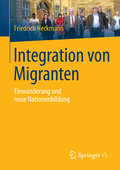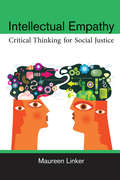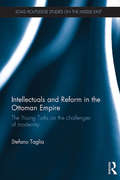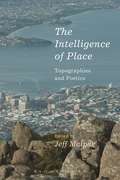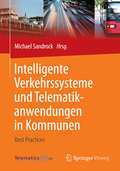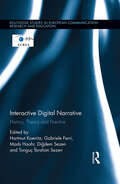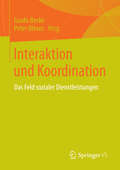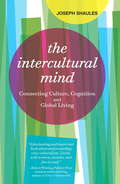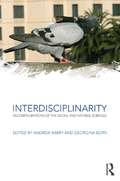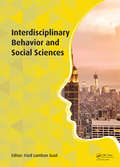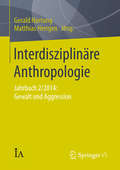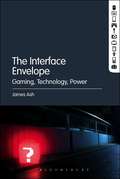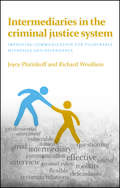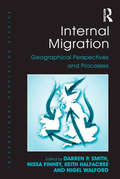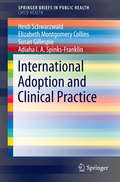- Table View
- List View
Integration von Migranten: Einwanderung und neue Nationenbildung
by Friedrich HeckmannDeutschland hat sich verändert. Migration und Integration sind zu konstitutiven Merkmalen seiner Sozial- und Gesellschaftsstruktur geworden. Mit gegenwärtigen und in Zukunft zu erwartenden neuen Zyklen von Einwanderung wird Integration von Migranten zur gesellschaftlichen Daueraufgabe. Dieses Buch hat zum einen das Ziel, gesellschaftliche Wirklichkeit von Integrationsprozessen darzustellen; zum anderen sozialwissenschaftliche Theorien zur Erklärung der Entstehung und des Verlaufs von Integrationsprozessen vorzustellen sowie praktische Maßnahmen zu diskutieren, diese Prozesse mittels Integrationspolitik zu beeinflussen.
Intellectual Empathy: Critical Thinking for Social Justice
by Maureen LinkerIntellectual Empathy provides a step-by-step method for facilitating discussions of socially divisive issues. Maureen Linker, a philosophy professor at the University of Michigan–Dearborn, developed Intellectual Empathy after more than a decade of teaching critical thinking in metropolitan Detroit, one of the most racially and economically divided urban areas, at the crossroads of one of the Midwest’s largest Muslim communities. The skills acquired through Intellectual Empathy have proven to be significant for students who pursue careers in education, social work, law, business, and medicine. Now, Linker shows educators, activists, business managers, community leaders—anyone working toward fruitful dialogues about social differences—how potentially transformative conversations break down and how they can be repaired. Starting from Socrates’s injunction know thyself, Linker explains why interrogating our own beliefs is essential. In contrast to traditional approaches in logic that devalue emotion, Linker acknowledges the affective aspects of reasoning and how emotion is embedded in our understanding of self and other. Using examples from classroom dialogues, online comment forums, news media, and diversity training workshops, readers learn to recognize logical fallacies and critically, yet empathically, assess their own social biases, as well as the structural inequalities that perpetuate social injustice and divide us from each other.
Intellectuals and Reform in the Ottoman Empire: The Young Turks on the Challenges of Modernity (SOAS/Routledge Studies on the Middle East)
by Stefano TagliaThis book uncovers Young Turk political and social ideas at the end of the nineteenth century, during the intellectual phase of the movement. Analysing the life in exile of two of the most charismatic leaders of the Young Turk movement, Ahmed Rıza and Mehmet Sabahattin, the book unravels their plans for the future of the Ottoman Empire, covering issues of power, religion, citizenship, minority rights, the role of the West, and the accountability of the Sultan. The book follows Rıza and Sabahattin through their association with philosophical circles, and highlights how their emphasis on intellectualism and elitism had a twofold effect. On the one hand, seeing themselves as enlightened and entrusted with a mission, they engaged in enduring debates, leaving an important legacy for both Ottoman and Republican rule. On the other hand, the rigidity resulting from elitism and intellectualism prevented the conception of concrete plans for change, causing a schism at the 1902 Congress of Ottoman Liberals and marking the end of the intellectual phase. Using bilingual period journals, contemporary accounts, police archives and political and philosophical treaties, this book is of interest to students, scholars and researchers of Middle East and Ottoman History, and Political Science more broadly.
Intellectuals and Reform in the Ottoman Empire: The Young Turks on the Challenges of Modernity (SOAS/Routledge Studies on the Middle East)
by Stefano TagliaThis book uncovers Young Turk political and social ideas at the end of the nineteenth century, during the intellectual phase of the movement. Analysing the life in exile of two of the most charismatic leaders of the Young Turk movement, Ahmed Rıza and Mehmet Sabahattin, the book unravels their plans for the future of the Ottoman Empire, covering issues of power, religion, citizenship, minority rights, the role of the West, and the accountability of the Sultan. The book follows Rıza and Sabahattin through their association with philosophical circles, and highlights how their emphasis on intellectualism and elitism had a twofold effect. On the one hand, seeing themselves as enlightened and entrusted with a mission, they engaged in enduring debates, leaving an important legacy for both Ottoman and Republican rule. On the other hand, the rigidity resulting from elitism and intellectualism prevented the conception of concrete plans for change, causing a schism at the 1902 Congress of Ottoman Liberals and marking the end of the intellectual phase. Using bilingual period journals, contemporary accounts, police archives and political and philosophical treaties, this book is of interest to students, scholars and researchers of Middle East and Ottoman History, and Political Science more broadly.
The Intelligence of Place: Topographies and Poetics
by Jeff MalpasPlace has become a widespread concept in contemporary work in the humanities, creative arts, and social sciences. Yet in spite of its centrality, place remains a concept more often deployed than interrogated, and there are relatively few works that focus directly on the concept of place as such. The Intelligence of Place fills this gap, providing an exploration of place from various perspectives, encompassing anthropology, architecture, geography, media, philosophy, and the arts, and as it stands in relation to a range of other concepts. Drawing together many of the key thinkers currently writing on the topic, The Intelligence of Place offers a unique point of entry into the contemporary thinking of place – into its topographies and poetics – providing new insights into a concept crucial to understanding our world and ourselves.
The Intelligence of Place: Topographies and Poetics
by Jeff MalpasPlace has become a widespread concept in contemporary work in the humanities, creative arts, and social sciences. Yet in spite of its centrality, place remains a concept more often deployed than interrogated, and there are relatively few works that focus directly on the concept of place as such. The Intelligence of Place fills this gap, providing an exploration of place from various perspectives, encompassing anthropology, architecture, geography, media, philosophy, and the arts, and as it stands in relation to a range of other concepts. Drawing together many of the key thinkers currently writing on the topic, The Intelligence of Place offers a unique point of entry into the contemporary thinking of place – into its topographies and poetics – providing new insights into a concept crucial to understanding our world and ourselves.
Intelligente Verkehrssysteme und Telematikanwendungen in Kommunen: Best Practices
by Michael SandrockDie europäische Telematikgesellschaft TelematicsPRO e.V. hat mit dem Wettbewerb "Best-Practice-Telematik in Kommunen" einen Leuchtturm gesetzt für herausragende kommunale Innovationen. Erstmals wurde der Preis im Jahr 2013 an die Preisträger der Stadt Friedrichshafen, dem Landkreis Schwäbisch Hall, der Stadt Düsseldorf und der Stadt Böblingen vergeben. TelematicsPRO hat zwei der Preisträger aufgefordert, ihre Wettbewerbsbeiträge für das vorliegende Buch zu präsentieren. Zwei weitere Beiträge entstammen dem Wettbewerbsumfeld – es handelt sich um Leistungsinhalte von zwei Softwareunternehmen: highQ Computerlösungen (Freiburg) und PRISMA solutions (Mödling). Beschrieben werden die elektronischen Bezahlprozesse bei Mobilitätsketten, der Einsatz von Softwaremodulen für kommunale Lösungen. Eine zusätzliche Beschreibung eines mobilitätsgerichteten Overlaysystems ergänzt diese Abhandlung.
Interactive Digital Narrative: History, Theory and Practice (Routledge Studies in European Communication Research and Education)
by Hartmut Koenitz Mads Haahr Gabriele Ferri Di 287 Dem Sezen Tonguç 304 Brahim SezenThe book is concerned with narrative in digital media that changes according to user input—Interactive Digital Narrative (IDN). It provides a broad overview of current issues and future directions in this multi-disciplinary field that includes humanities-based and computational perspectives. It assembles the voices of leading researchers and practitioners like Janet Murray, Marie-Laure Ryan, Scott Rettberg and Martin Rieser. In three sections, it covers history, theoretical perspectives and varieties of practice including narrative game design, with a special focus on changes in the power relationship between audience and author enabled by interactivity. After discussing the historical development of diverse forms, the book presents theoretical standpoints including a semiotic perspective, a proposal for a specific theoretical framework and an inquiry into the role of artificial intelligence. Finally, it analyses varieties of current practice from digital poetry to location-based applications, artistic experiments and expanded remakes of older narrative game titles.
Interactive Digital Narrative: History, Theory and Practice (Routledge Studies in European Communication Research and Education)
by Hartmut Koenitz Mads Haahr Gabriele Ferri Diğdem Sezen Tonguç İbrahim SezenThe book is concerned with narrative in digital media that changes according to user input—Interactive Digital Narrative (IDN). It provides a broad overview of current issues and future directions in this multi-disciplinary field that includes humanities-based and computational perspectives. It assembles the voices of leading researchers and practitioners like Janet Murray, Marie-Laure Ryan, Scott Rettberg and Martin Rieser. In three sections, it covers history, theoretical perspectives and varieties of practice including narrative game design, with a special focus on changes in the power relationship between audience and author enabled by interactivity. After discussing the historical development of diverse forms, the book presents theoretical standpoints including a semiotic perspective, a proposal for a specific theoretical framework and an inquiry into the role of artificial intelligence. Finally, it analyses varieties of current practice from digital poetry to location-based applications, artistic experiments and expanded remakes of older narrative game titles.
Interaktion und Koordination: Das Feld sozialer Dienstleistungen
by Guido Becke Peter BlesesIn diesem Band wird die in der wissenschaftlichen Debatte bislang wenig beachtete Wechselbeziehung zwischen Interaktions- und Koordinationsarbeit am Beispiel sozialer Dienstleistungen beleuchtet: Koordinationsarbeit bildet beispielsweise eine wesentliche Voraussetzung für gelungene Interaktionsarbeit; Koordinationsarbeit beinhaltet selbst auch Interaktionsarbeit. Der Zusammenhang zwischen Interaktions- und Koordinationsarbeit wird in theoretisch-konzeptioneller Hinsicht und auf Basis empirischer Befunde aus verschiedenen Handlungsfeldern sozialer Dienstleistungen hin entfaltet. Auf dieser Grundlage werden Gestaltungsansätze für eine nachhaltige Arbeitsqualität von Interaktions- und Koordinationsarbeit sowie ein erweitertes Produktivitätsverständnis sozialer Dienstleistungen aufgezeigt.
Interaktionen von Fußballfans: Das Spiel am Rande des Spiels
by Martin WinandsMartin Winands untersucht in einer ethnographischen Studie die Interaktionen von Fußballfans im Stadion und entwickelt eine eigene, gegenstandsgegründete Theorie der Interaktionsordnungen. Die Analysen werden maßgeblich von den theoretischen Ausführungen Goffmans beeinflusst, auf deren Basis ein sensibilisierendes Konzept entwickelt wird. Die grundlagenwissenschaftlich angelegte Forschung gibt Impulse für eine theoretisch wie empirisch fundierte Fansozialforschung und es werden analytische Angebote für die handlungsorientierte Fansozialarbeit vorgeschlagen. Die Analysen zeigen, dass die Ultragruppen im Zentrum der Interaktionen stehen und vielerorts die Stimmung in den Stadien von ihnen abhängig ist. Zudem werden autoritäre Muster sichtbar, da die Ultragruppen häufig darüber entscheiden, welche Artikulationen legitim sind und welche nicht.
The Intercultural Mind: Connecting Culture, Cognition, and Global Living
by Joseph ShaulesIn this pioneering book, Joseph Shaules presents exciting new research from cultural psychology and neuroscience. It sheds light on the hidden influence of culture on the unconscious mind, and helps people get more out of their intercultural journeys.The Intercultural Mind presents new perspectives on important questions such as: What is culture shock, and how does it affect us? Why are we blind to our own cultural conditioning? Can cultural differences be measured? What does it mean to have an international mindset? Illustrated with a wealth of examples and memorable stories, The Intercultural Mind is a fascinating look at how intercultural experiences can transform the geography of our minds.
Interdisciplinarity: Reconfigurations of the Social and Natural Sciences (CRESC)
by Andrew Barry Georgina BornThe idea that research should become more interdisciplinary has become commonplace. According to influential commentators, the unprecedented complexity of problems such as climate change or the social implications of biomedicine demand interdisciplinary efforts integrating both the social and natural sciences. In this context, the question of whether a given knowledge practice is too disciplinary, or interdisciplinary, or not disciplinary enough has become an issue for governments, research policy makers and funding agencies. Interdisciplinarity, in short, has emerged as a key political preoccupation; yet the term tends to obscure as much as illuminate the diverse practices gathered under its rubric. This volume offers a new approach to theorising interdisciplinarity, showing how the boundaries between the social and natural sciences are being reconfigured. It examines the current preoccupation with interdisciplinarity, notably the ascendance of a particular discourse in which it is associated with a transformation in the relations between science, technology and society. Contributors address attempts to promote collaboration between, on the one hand, the natural sciences and engineering and, on the other, the social sciences, arts and humanities. From ethnography in the IT industry to science and technology studies, environmental science to medical humanities, cybernetics to art-science, the collection interrogates how interdisciplinarity has come to be seen as a solution not only to enhancing relations between science and society, but the pursuit of accountability and the need to foster innovation. Interdisciplinarity is essential reading for scholars, students and policy makers across the social sciences, arts and humanities, including anthropology, geography, sociology, science and technology studies and cultural studies, as well as all those engaged in interdisciplinary research. It will have particular relevance for those concerned with the knowledge economy, science policy, environmental politics, applied anthropology, ELSI research, medical humanities, and art-science.
Interdisciplinarity: Reconfigurations of the Social and Natural Sciences (CRESC)
by Andrew Barry Georgina BornThe idea that research should become more interdisciplinary has become commonplace. According to influential commentators, the unprecedented complexity of problems such as climate change or the social implications of biomedicine demand interdisciplinary efforts integrating both the social and natural sciences. In this context, the question of whether a given knowledge practice is too disciplinary, or interdisciplinary, or not disciplinary enough has become an issue for governments, research policy makers and funding agencies. Interdisciplinarity, in short, has emerged as a key political preoccupation; yet the term tends to obscure as much as illuminate the diverse practices gathered under its rubric. This volume offers a new approach to theorising interdisciplinarity, showing how the boundaries between the social and natural sciences are being reconfigured. It examines the current preoccupation with interdisciplinarity, notably the ascendance of a particular discourse in which it is associated with a transformation in the relations between science, technology and society. Contributors address attempts to promote collaboration between, on the one hand, the natural sciences and engineering and, on the other, the social sciences, arts and humanities. From ethnography in the IT industry to science and technology studies, environmental science to medical humanities, cybernetics to art-science, the collection interrogates how interdisciplinarity has come to be seen as a solution not only to enhancing relations between science and society, but the pursuit of accountability and the need to foster innovation. Interdisciplinarity is essential reading for scholars, students and policy makers across the social sciences, arts and humanities, including anthropology, geography, sociology, science and technology studies and cultural studies, as well as all those engaged in interdisciplinary research. It will have particular relevance for those concerned with the knowledge economy, science policy, environmental politics, applied anthropology, ELSI research, medical humanities, and art-science.
Interdisciplinary Behavior and Social Sciences: Proceedings of the 3rd International Congress on Interdisciplinary Behavior and Social Science 2014 (ICIBSoS 2014), 1-2 November 2014, Bali, Indonesia.
by Ford Lumban GaolThe human aspect plays an important role in the social sciences. The behavior of people has become a vital area of focus in the social sciences as well. Interdisciplinary Behavior and Social Sciences contains papers that were originally presented at the 3rd International Congress on Interdisciplinary Behavior and Social Science 2014 (ICIBSoS 2014),
Interdisciplining Digital Humanities: Boundary Work in an Emerging Field (Digital Humanities)
by Julie T KleinInterdisciplining Digital Humanities sorts through definitions and patterns of practice over roughly sixty-five years of work, providing an overview for specialists and a general audience alike. It is the only book that tests the widespread claim that Digital Humanities is interdisciplinary. By examining the boundary work of constructing, expanding, and sustaining a new field, it depicts both the ways this new field is being situated within individual domains and dynamic cross-fertilizations that are fostering new relationships across academic boundaries. It also accounts for digital reinvigorations of “public humanities” in cultural heritage institutions of museums, archives, libraries, and community forums.
Interdisziplinäre Anthropologie: Jahrbuch 2/2014: Gewalt und Aggression (Interdisziplinäre Anthropologie)
by Gerald Hartung Matthias HerrgenGewalt und Aggression gehören zu den zentralen Problemen der Anthropologie. Dieser Band versammelt Beiträge von Natur-, Geistes und Sozialwissenschaftlern, um einen interdisziplinären Dialog zum Thema Gewalt zu eröffnen. Der Diskursteil enthält einen Hauptbeitrag aus sozialpsychologischer Perspektive, Kommentare aus unterschiedlichen Fachgebieten und eine Replik der Autorin. Zusätzliche Forschungsbeiträge erweitern den Themenschwerpunkt des Bandes. Komplettiert wird das Jahrbuch mit den Rubriken „Beiträge“, „Berichte“, „Rezensionen“ und „Kalender“, die allesamt Beiträge zur Diskussionslandschaft einer Interdisziplinären Anthropologie bieten.
The Interface Envelope: Gaming, Technology, Power
by James AshIn The Interface Envelope, James Ash develops a series of concepts to understand how digital interfaces work to shape the spatial and temporal perception of players. Drawing upon examples from videogame design and work from post-phenomenology, speculative realism, new materialism and media theory, Ash argues that interfaces create envelopes, or localised foldings of space time, around which bodily and perceptual capacities are organised for the explicit production of economic profit. Modifying and developing Bernard Stiegler's account of psychopower and Warren Neidich's account of neuropower, Ash argues the aim of interface designers and publishers is the production of envelope power. Envelope power refers to the ways that interfaces in games are designed to increase users perceptual and habitual capacities to sense difference. Examining a range of examples from specific videogames, Ash identities a series of logics that are key to producing envelope power and shows how these logics have intensified over the last thirty years. In turn, Ash suggests that the logics of interface envelopes in videogames are spreading to other types of interface. In doing so life becomes enveloped as the environments people inhabit becoming increasingly loaded with digital interfaces. Rather than simply negative, Ash develops a series of responses to the potential problematics of interface envelopes and envelope power and emphasizes their pharmacological nature.
The Interface Envelope: Gaming, Technology, Power
by James AshIn The Interface Envelope, James Ash develops a series of concepts to understand how digital interfaces work to shape the spatial and temporal perception of players. Drawing upon examples from videogame design and work from post-phenomenology, speculative realism, new materialism and media theory, Ash argues that interfaces create envelopes, or localised foldings of space time, around which bodily and perceptual capacities are organised for the explicit production of economic profit. Modifying and developing Bernard Stiegler's account of psychopower and Warren Neidich's account of neuropower, Ash argues the aim of interface designers and publishers is the production of envelope power. Envelope power refers to the ways that interfaces in games are designed to increase users perceptual and habitual capacities to sense difference. Examining a range of examples from specific videogames, Ash identities a series of logics that are key to producing envelope power and shows how these logics have intensified over the last thirty years. In turn, Ash suggests that the logics of interface envelopes in videogames are spreading to other types of interface. In doing so life becomes enveloped as the environments people inhabit becoming increasingly loaded with digital interfaces. Rather than simply negative, Ash develops a series of responses to the potential problematics of interface envelopes and envelope power and emphasizes their pharmacological nature.
Intermarriage and Mixed Parenting, Promoting Mental Health and Wellbeing: Crossover Love
by R. SinglaMarriages across ethnic borders are increasing in frequency, yet little is known of how discourses of 'normal' families, ethnicity, race, migration, globalisation affect couples and children involved in these mixed marriages. This book explores mixed marriage though intimate stories drawn from the real lives of visibly different couples.
Intermediaries in the criminal justice system: Improving communication for vulnerable witnesses and defendants
by Joyce Plotnikoff Richard WoolfsonThis is the first book about the intermediary scheme, criminal justice’s untold ‘good news story’. Intermediaries are independent communication specialists who assist children and vulnerable adults at police interviews and trials, helping to improve the quality of their evidence and providing access to justice for those who previously had been excluded. Richly illustrated with case examples through intermediaries’ own descriptions of their work, the book also includes feedback from justice system personnel and over 70 judges. This unique book provides a comprehensive explanation of how intermediaries work in practice and gives ‘behind the scenes’ insights into the criminal process. It will be of interest to practitioners and the wider public in England and Wales and encourage consideration of the scheme elsewhere.
Intermediaries in the criminal justice system: Improving communication for vulnerable witnesses and defendants
by Joyce Plotnikoff Richard WoolfsonThis is the first book about the intermediary scheme, criminal justice’s untold ‘good news story’. Intermediaries are independent communication specialists who assist children and vulnerable adults at police interviews and trials, helping to improve the quality of their evidence and providing access to justice for those who previously had been excluded. Richly illustrated with case examples through intermediaries’ own descriptions of their work, the book also includes feedback from justice system personnel and over 70 judges. This unique book provides a comprehensive explanation of how intermediaries work in practice and gives ‘behind the scenes’ insights into the criminal process. It will be of interest to practitioners and the wider public in England and Wales and encourage consideration of the scheme elsewhere.
Internal Migration: Geographical Perspectives and Processes (International Population Studies)
by Nigel Walford Nissa Finney Darren P. SmithOver the last two decades there have been numerous profound changes in UK society which have had an impact on the scale, geographies, meaning and experiences of internal migration. Providing a critical appraisal of migration scholarship from the perspective of Geography, reviewing theory, substantive foci and method, this book demonstrates how sub-national migration in the UK gives rise to and reflects new patterns of population, housing, economies and cultures. Each chapter is written by a Population Geographer together with a scholar representing another Human Geography sub-discipline thus providing a cross-disciplinary perspective on a specific aspect of migration. Critically reviewing and setting an agenda for internal migration scholarship from a spatial perspective, this book will be of interest to academics and students of Geography and other disciplines concerned with migration, both within the UK and further afield.
Internal Migration: Geographical Perspectives and Processes (International Population Studies)
by Nigel Walford Nissa Finney Darren P. SmithOver the last two decades there have been numerous profound changes in UK society which have had an impact on the scale, geographies, meaning and experiences of internal migration. Providing a critical appraisal of migration scholarship from the perspective of Geography, reviewing theory, substantive foci and method, this book demonstrates how sub-national migration in the UK gives rise to and reflects new patterns of population, housing, economies and cultures. Each chapter is written by a Population Geographer together with a scholar representing another Human Geography sub-discipline thus providing a cross-disciplinary perspective on a specific aspect of migration. Critically reviewing and setting an agenda for internal migration scholarship from a spatial perspective, this book will be of interest to academics and students of Geography and other disciplines concerned with migration, both within the UK and further afield.
International Adoption and Clinical Practice (SpringerBriefs in Public Health #0)
by Heidi Schwarzwald Elizabeth Montgomery Collins Susan Gillespie Adiaha I. Spinks-FranklinNo matter how positive the intent of prospective parents, international adoption is fraught with emotional, medical, administrative, linguistic, and geopolitical issues. And while a wide range of professionals supports adopted children and their families in adjusting to the inherent changes and disruptions, the pediatrician's tasks--identifying and treating existing health problems and preventing numerous others--are particularly complex. International Adoption and Clinical Practice equips pediatricians with a comprehensive set of tools for establishing a long-term care plan and creating interventions to promote healthy development. This concise guide overviews the intricacies of the international adoption process and how they can affect the pediatrician's job, from potential pitfalls in collecting medical data from a child's birth country to tracking health concerns into adolescence and young adulthood. Developmental and behavioral issues including attachment, language acquisition, identity development, and consequences of abuse and neglect are also examined in this context. Figures, tables, and reference lists complement current information on topics such as:Epidemiology and demographics of international adoption.Pre-adoption evaluation of medical records.Guidelines for diagnostic testing, screening, laboratory evaluations, and immunizations.Common mental health issues faced by adopted children and their families.Long-term and adult outcomes of international adoption.Relevant policy issues and areas for future study. Every child deserves a safe and healthy home, and International Adoption and Clinical Practice gives pediatricians an in-depth framework for helping to make this possible as children make the transition to a new country and the next stage of their lives.
